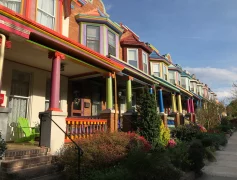
Helping Pollinators in Small Green Spaces
Thanks to the University of Maryland/Maryland Grows this informative article on helping pollinators.
Spring is almost almost here, and if you’re like me, you have already started visualizing what flowers will grow where and what pollinators you’ll need to keep an eye out for. Unlike in other posts, where we talked about how to help pollinators in large spaces, today we’ll talk about how to help them in very small yards, balconies, porches, or other small spaces.
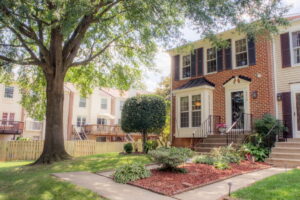
Small yards
If you have access to a small yard, plenty of opportunities are available! Of course, you will not be able to plant lots of large plants, but that doesn’t mean you cannot plant anything. When offered little space, you can use not just the horizontal, but also the vertical space. While it is possible to cover the ground with a mix of perennials and annuals, there are also possibilities of installing trellises on which flowering vines can grow.

Some native perennial plants that can easily fit into small yards and that are attractive to pollinators of our region are different species of the genus Monarda, such as wild bergamot (Monarda fistulosa), or the spotted bee balm (Monarda punctata). These plants are favorites of bees, flies, and butterflies, and, although they can be relatively tall (about 2 feet), they are very productive and lovely to look at.
Other perennials that are easy to grow, do not require a lot of space, and do well in sunny spots are the lovely Eastern columbines (Aquilegia canadensis). These plants are among our first blooms in the spring and are great floral resources for hummingbirds, bees, and butterflies. Black-eyed Susans (Rudbeckia hirta) are also easy to grow, produce showy flowers that are very attractive to many pollinators, and do relatively well in not-so-sunny conditions. Cardinal flowers (Lobelia cardinalis) are also great for supporting hummingbirds, and the fact that they can flower for a long time makes them not only a good addition to a small yard but also a fun way to watch hummingbirds for several weeks!
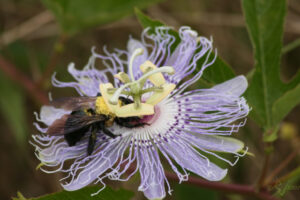
Vertical space
Small yards are great places to increase flower diversity using the vertical space. With trellises, you can support vines that can act both as hosts of caterpillars and then provide nectar and pollen resources for adult pollinators. For instance, the lovely trumpet honeysuckle (Lonicera sempervirens) is a great native hummingbird magnet, the stunning passionflower (Passiflora incarnata) can feed bees with its pollen and nectar (and then feed us with the ripe fruits!), and pipevines (Aristolochia macrophylla) can serve as host of pipevine swallowtail caterpillars and surprise us with their intricate flowers.
Balconies and porches
Not having open ground spaces does not mean you cannot support pollinators. You can support them by providing floral resources grown in pots! Again, here, both the horizontal and vertical spaces can be used, using planters placed on the ground, but also being aware of the possibility of hanging plants as well!
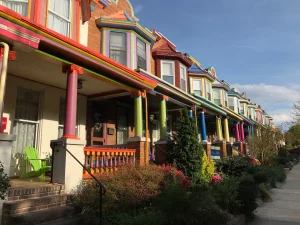
Something important to consider when choosing pollinator plants to grow in pots is the amount of space available and sunlight. This will define the type and size of plant appropriate to grow in a particular situation. Here, again, there are multiple options since both annuals and perennials can be grown in these more restricted spaces.
Native perennials
A good native perennial plant to grow in porches and balconies is wild blue phlox (Phlox divaricata). They grow early in the season and attracts many pollinators. Beardtongues (Penstemon digitalis) are beautiful plants that grow well in pots and attract hummingbirds. Another fun alternative for supporting pollinators is planting butterfly weed (Asclepias tuberosa). They invite monarch butterflies, allowing one to observe the development of these caterpillars right on our balconies and porches (note, however, that caterpillars will feed on the plant, so planting several plants may be a good idea).
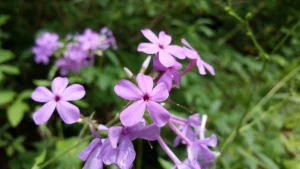
Although non-native, some plants that we can grow on our balconies and porches can also be great for pollinators… and for ourselves! In fact, growing herbs is both an easy way to have fresh condiments for our foods. It is also a great resource for caterpillars, pollinating bees, beetles, and other insects. Some particularly good ones are dill and parsley, which act as great host plants for black swallowtail caterpillars.
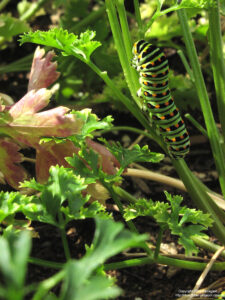
There are of course many more options than just these! If you want to take a look at them, check out this great compilation. It was put together by the Department of Natural Resources. And if you are ready to get some plants, take a look at this list of local nurseries that sell natives.
It’s not all about the plants!
Besides establishing plants that provide good food resources for our pollinators, do not forget that pollinators also need a place to live! A great way to use small spaces for pollinators is to establish spaces where they can nest. A simple way to do this in small spaces is by installing bee hotels.
Finally, many pollinators can obtain water from nectar. This is especially true during the heat of summer. It is key for them to have access to water. If you have room, a container filled with some water and some landing surfaces can go a long way (take a look here for some easy and fun ideas).
By Anahí Espíndola, Assistant Professor, Department of Entomology, University of Maryland, College Park. See more posts by Anahí.
Anahí also writes an Extension Blog in Spanish! Check it out here, extensionesp.umd.edu, and please share and spread the word to your Spanish-speaking friends and colleagues in Maryland. ¡Bienvenidos a Extensión en Español!
Oh by the way, I’m never too busy for any of your referrals! If you are looking to buy or sell your home (with or without a garden), contact Gigi today.






Recent Comments